Title
题目
A generalizable diffusion framework for 3D low-dose and few-view cardiacSPECT imaging
一种适用于 3D 低剂量和少视角心脏单光子发射计算机断层成像(SPECT)的可泛化扩散框架
01
文献速递介绍
心血管疾病(CVDs)是全球范围内导致死亡的首要原因(Tsao 等,2023)。心脏单光子发射计算机断层成像(SPECT)在心血管疾病的诊断中发挥着关键作用(Dobrucki 和 Sinusas,2010),而利用 SPECT 进行的心肌灌注显像(MPI)仍是核心脏病学中应用最广泛的检查手段(Abbott 等,2018)。鉴于人们对 SPECT 扫描带来的辐射暴露以及潜在癌症风险增加的担忧日益加剧,降低 SPECT 注射剂量具有重要意义(Lin,2010)。此外,通过缩短扫描时间减少图像运动伪影和患者不适,以及在性价比更高的扫描仪上提升图像质量,在临床场景中也颇具价值。 然而,降低注射剂量和缩短扫描时间会对图像质量和诊断性能产生不利影响。因此,从欠采样测量数据中重建出临床可接受的图像成为一个重要研究课题。在本文中,欠采样数据既包括低剂量数据,也包括少视角数据。传统的迭代重建方法难以利用欠采样测量数据生成令人满意的图像。深度学习技术在医学图像质量提升方面的研究一直十分活跃(Wang 等,2020)。针对不同采集条件下的 SPECT 图像重建/恢复,已提出多种深度学习方法,包括低剂量/低计数 SPECT 成像(Ramon 等,2020;Aghakhan Olia 等,2022;Chen 等,2024;Du 等,2024)以及少视角/有限角度 SPECT 成像(Xie 等,2022,2023b,c,2024a)。特别是随着前沿生成模型的发展(Croitoru 等,2023;Kazerouni 等,2022),扩散模型在核成像质量提升方面展现出巨大潜力。例如,Lai 等近期研究了在正弦图域中使用扩散模型对低剂量 SPECT 图像进行去噪(Lai 等)。扩散模型在 PET 成像中也取得了良好效果,例如,基于去噪扩散概率模型(DDPM)(Ho 等,2020),Gong 等提出结合 MRI 作为先验信息进行 2D PET 图像去噪(Gong 等,2023 - 10 - 03)。人们期望使用 3D 扩散模型处理整个图像体积,但受硬件内存限制,这一想法难以实现。为解决扩散模型在 3D 成像中的问题,我们先前的研究(Xie 等,2024)提出了 DDPET - 3D,这是一种剂量感知扩散模型,用于不同噪声水平下的 3D PET 图像去噪。扩散模型在其他成像模态中的研究也在开展(Gao 等,2023;Güngör 等,2023;Chung 和 Ye,2022)。但大多数深度学习模型是针对特定采集场景(如低剂量或少视角)设计的,难以泛化到其他场景。例如,低剂量成像模型通常难以在少视角成像中产生最佳结果,这限制了其在实际临床场景中的应用。本研究旨在提出一种扩散框架,用于不同采集条件(即低剂量和少视角场景)下的可泛化 3D SPECT 成像,且无需进一步对网络进行微调或重训练。要实现这一目标,需要解决若干挑战。 首先,由于 SPECT 本质上是一种 3D 成像模态,需要一种能够考虑 3D 空间信息的模型。但如前所述,由于内存限制,直接训练 3D 扩散模型面临挑战。人们可以训练 2D 扩散模型,然后将所有 2D 切片堆叠起来生成 3D 图像体积。然而,正如我们先前的研究(Xie 等,2024)及本文后续所示,这种方法会导致沿 Z 轴的不同 2D 切片之间出现严重的不一致性。已有多项研究尝试解决扩散模型在 3D 成像中的挑战。Chung 等(2023b)提出在扩散模型的每个反向采样步骤中加入沿 Z 轴的总变分(TV)约束项,以减轻不一致性。Lee 等(2023)提出采用两个预训练的垂直 2D 扩散模型来消除切片之间的不一致性。但这两种方法在训练过程中无法获取 3D 空间信息,导致结果欠佳。相比之下,我们先前的研究提出了 2.5D 条件策略(Xie 等,2024),该策略允许网络观察相邻切片,且性能优于前两种方法。但先前提出的 2.5D 条件策略在图像重建时只能观察相邻的 n 个切片,导致感受野受限,在图像体积边缘尤为明显。 其次,在不同采集条件下实现可泛化的 SPECT 图像重建面临的另一挑战是图像伪影的高度变异性。从含噪投影数据重建的图像与从截断投影数据重建的图像具有不同的噪声模式,且噪声模式在不同的低剂量和少视角水平下也存在差异。为不同采集条件训练单独的网络虽可行,但这种方法资源消耗大,且由于临床协议的高度变异性,可能并不实用。此外,针对特定场景优化的模型可能难以有效泛化到未见过的采集条件,例如训练数据中未包含的低计数水平。因此,需要一种能够自适应地在不同采集条件下重建图像的方法。但先前提出的大多数深度学习方法对不同采集条件的泛化能力有限。为提高网络泛化性,我们先前提出结合多个基于 U - Net(Ronneberger 等,2015)的子网络,这些子网络具有不同的去噪能力,可为任何输入噪声水平生成最佳去噪结果(Xie 等,2023a)。在我们先前关于低剂量 PET 扩散的研究(Xie 等,2024)中,我们提出将注射剂量嵌入扩散模型,以实现剂量感知的 PET 去噪。我们还尝试将动态卷积的思想(Xie 等,2023 - 05;Li 等,2022)应用于动态 PET 图像去噪,以解决示踪剂衰减导致的早期和晚期帧之间噪声水平的变化(Xie 等,2025)。尽管这些方法提高了对不同图像噪声水平的适应性,但它们是专门为去噪任务设计的,未考虑其他采集场景(如少视角场景)下的挑战。 在本研究中,我们开发了一种扩散框架 DiffSPECT - 3D,用于不同采集条件下可泛化的 3D 心脏 SPECT 图像重建。所提出的 DiffSPECT - 3D 框架在方法上的主要贡献如下:第一,结合 CT 的 3D 空间解剖信息,我们提出了一种改进的 2.5D 条件策略,使网络能够在 3D SPECT 图像重建中观察整个 3D CT 体积,且内存负担增加可忽略不计。由于 CT 扫描通常与 SPECT 扫描同时进行以用于衰减校正,因此 CT 数据易于获取。受 Chung 等(2023b)的启发,在扩散采样中还加入了切片维度的 TV 惩罚项,以进一步改善结果。第二,为解决图像伪影高度变异性的挑战,我们在扩散反向采样过程中提出了一种一致性策略,使每个时间步的扩散预测与欠采样 SPECT 图像数据、投影数据以及扫描仪系统矩阵保持一致。为实现基于投影的一致性,DiffSPECT - 3D 将传统的迭代重建更新整合到扩散采样中。为实现基于图像的一致性,DiffSPECT - 3D 在每个扩散采样步骤中采用扩散后验采样(DPS)(Chung 等,2023a)策略。这两种技术确保扩散反向采样与测量的投影/图像数据以及扫描仪几何结构保持一致。最后,所提出的 DiffSPECT - 3D 的一个优势是,扩散训练过程不需要成对的 SPECT 输入/标签,仅需标签即可,省去了繁琐的数据准备工作。由于 SPECT 列表模式数据可能并不总是可用,因此无监督扩散训练的能力简化了训练过程,并有可能促进其向临床转化。
Aastract
摘要
Myocardial perfusion imaging using SPECT is widely utilized to diagnose coronary artery diseases, but imagequality can be negatively affected in low-dose and few-view acquisition settings. Although various deeplearning methods have been introduced to improve image quality from low-dose or few-view SPECT data,previous approaches often fail to generalize across different acquisition settings, limiting realistic applicability.This work introduced DiffSPECT-3D, a diffusion framework for 3D cardiac SPECT imaging that effectivelyadapts to different acquisition settings without requiring further network re-training or fine-tuning. Using bothimage and projection data, a consistency strategy is proposed to ensure that diffusion sampling at each stepaligns with the low-dose/few-view projection measurements, the image data, and the scanner geometry, thusenabling generalization to different low-dose/few-view settings. Incorporating anatomical spatial informationfrom CT and total variation constraint, we proposed a 2.5D conditional strategy to allow DiffSPECT-3D toobserve 3D contextual information from the entire image volume, addressing the 3D memory/computationalissues in diffusion model. We extensively evaluated the proposed method on 1,325 clinical 99mTc tetrofosminstress/rest studies from 795 patients. Each study was reconstructed into 5 different low-count levels and 5different projection few-view levels for model evaluations, ranging from 1% to 50% and from 1 view to9 view, respectively. Validated against cardiac catheterization results and diagnostic review from nuclearcardiologists, the presented results show the potential to achieve low-dose and few-view SPECT imagingwithout compromising clinical performance. Additionally, DiffSPECT-3D could be directly applied to full-doseSPECT images to further improve image quality, especially in a low-dose stress-first cardiac SPECT imagingprotocol.
单光子发射计算机断层成像(SPECT)心肌灌注显像被广泛用于冠状动脉疾病的诊断,但在低剂量和少视角采集场景下,图像质量会受到不良影响。尽管已有多种深度学习方法被用于从低剂量或少视角SPECT数据中提升图像质量,但以往的方法往往难以在不同采集场景间实现泛化,限制了其实际应用价值。本研究提出了DiffSPECT-3D——一种适用于3D心脏SPECT成像的扩散框架,该框架无需进一步的网络重训练或微调,就能有效适配不同的采集场景。通过同时利用图像数据和投影数据,研究提出了一种一致性策略,确保扩散采样的每一步都与低剂量/少视角投影测量值、图像数据以及扫描仪几何结构保持一致,从而实现对不同低剂量/少视角场景的泛化。结合计算机断层成像(CT)的解剖学空间信息和总变分约束,研究提出了2.5D条件策略,使DiffSPECT-3D能够从整个图像体积中获取3D上下文信息,解决了扩散模型中的3D内存/计算问题。研究在来自795例患者的1325例临床⁹⁹ᵐTc替曲膦负荷/静息显像研究中对所提方法进行了全面评估。为进行模型评估,每例研究被重建为5种不同的低计数水平(范围从1%到50%)和5种不同的投影少视角水平(范围从1视角到9视角)。经心脏导管检查结果和核医学科医师的诊断评估验证,研究结果表明,该方法有望在不降低临床性能的前提下实现低剂量和少视角SPECT成像。此外,DiffSPECT-3D还可直接应用于全剂量SPECT图像以进一步提升图像质量,尤其适用于“低剂量负荷优先”的心脏SPECT成像协议。
Method
方法
2.1. Data acquisition and image reconstructionA total of 1325 clinical SPECT-CT stress/rest myocardial perfusionimaging (MPI) studies from 795 patients were included in this work.Note that not all patients have both stress and rest studies, due tothe stress-first protocol. All studies were acquired at the Yale NewHaven Hospital on a GE Discovery NM/CT (DNM) 570c (GE Healthcare,Milwaukee, Wisconsin, USA) (Bocher et al., 2010) dedicated SPECTCT system following the injection of 99mTc-tetrofosmin. All the dataused in this study were de-identified prior to model training, validation,testing, and follow-up analysis. Approval of all ethical and experimentalprocedures and protocols was granted by the institutional review board(IRB) at Yale University.As illustrated in Fig. 1(a), arranged into 3 rows, the DNM consistsof 19 cadmium zinc telluride (CZT) detector modules with tungstenpinhole collimators. Specifically, there are 5, 9, and 5 detectors placedon the top, central, and bottom rows, respectively (Chan et al., 2016)All 19 detector modules are designed to simultaneously acquire 19 projections over an L-shape arc for imaging without moving the scanner.In DNM, all 19 pinhole detector modules are focused on the cardiacregion to maximize imaging sensitivity over a sphere of approximately19-cm-diameter field of view (FOV). Each detector module in DNMhas full view of the heart and therefore can spend the full acquisitiontime to acquire photons emitted from the heart for better image qualitycompared to conventional dual-head SPECT systems (Xie et al., 2022).CZT-based systems are generally more expensive compared to conventional thallium doping NaI(Tl) cameras. GE has a cost-effective variantof DNM — the MyoSPECT ES system. The GE MyoSPECT ES systemshares similar geometry to DNM but it only comprises the 9 centraldetectors instead of the three-row 19 detectors, as illustrated in Fig.1(a).Following the clinical protocol, all images were reconstructed usingthe Maximum-Likelihood Expectation-Maximization (MLEM) (Sheppand Vardi, 1982; Lange and Carson, 1984) algorithm with 50 iterations.No post-filtering was applied to better visualize the improvements inimage quality and the recovery of anatomical structures. The reconstruction matrix size was 50 × 70 × 70 with a 4 × 4 × 4 mm3 voxel size.The dimension of 3D projection data is 32 × 32 × 19. CT scans wereobtained and registered for attenuation correction and neural networktraining/validation/testing.To evaluate the network performance under varying acquisitionsettings, images were reconstructed at low-count levels of 1%, 5%,10%, 20%, and 50% by equally down-sampling the listmode events.Additionally, few-view/limited-angle images were reconstructed at 1,3, 5, 7, and 9 view by cropping the data in the projection domain.Note that the 9-view setting simulates the configurations of the GEMyoSPECT ES system.Although this study focuses primarily on the GE DNM and/orMyoSPECT ES systems, we believe that the proposed method could beeasily extended to other imaging systems. As detailed below, this isbecause the network incorporates the scanner system matrix/imaginggeometry within the neural network reconstruction process, and doesnot heavily rely on paired training inputs/labels.
2.1. 数据采集与图像重建 本研究共纳入来自795例患者的1325例临床SPECT-CT负荷/静息心肌灌注显像(MPI)研究。需注意,由于采用“负荷优先”协议,并非所有患者都同时具备负荷和静息研究数据。所有研究均在耶鲁纽黑文医院使用GE Discovery NM/CT(DNM)570c(GE医疗,美国威斯康星州密尔沃基)专用SPECT-CT系统采集,患者注射⁹⁹ᵐTc-替曲膦后进行显像。本研究中使用的所有数据在模型训练、验证、测试及后续分析前均已去标识化处理。所有伦理和实验流程及协议均获得耶鲁大学机构审查委员会(IRB)的批准。 如图1(a)所示,DNM系统由19个碲锌镉(CZT)探测器模块组成,这些模块配有钨针孔准直器,分为3排排列。具体而言,顶部、中部和底部排分别装有5、9和5个探测器(Chan等,2016)。19个探测器模块设计为可在L形弧线上同时采集19个投影,无需移动扫描仪即可完成成像。在DNM系统中,所有19个针孔探测器模块均聚焦于心脏区域,以在直径约19厘米的视野(FOV)范围内最大化成像灵敏度。与传统双探头SPECT系统相比,DNM中的每个探测器模块都能完整观察心脏,因此可在整个采集时间内持续采集心脏发射的光子,从而获得更高的图像质量(Xie等,2022)。基于CZT的系统通常比传统铊掺杂碘化钠(NaI(Tl))相机更昂贵。GE公司推出了DNM的经济型变体——MyoSPECT ES系统。GE MyoSPECT ES系统与DNM的几何结构相似,但仅包含9个中部探测器,而非三排19个探测器,如图1(a)所示。 按照临床协议,所有图像均采用最大似然期望最大化(MLEM)算法(Shepp和Vardi,1982;Lange和Carson,1984)重建,迭代次数为50次。未应用后滤波处理,以便更清晰地观察图像质量的改善和解剖结构的恢复效果。重建矩阵大小为50×70×70,体素大小为4×4×4 mm³。3D投影数据的维度为32×32×19。同时获取CT扫描数据并进行配准,用于衰减校正和神经网络的训练/验证/测试。 为评估网络在不同采集条件下的性能,通过对列表模式事件进行均等下采样,在1%、5%、10%、20%和50%的低计数水平下重建图像。此外,通过在投影域裁剪数据,在1、3、5、7和9个视角下重建少视角/有限角度图像。需注意,9视角设置模拟了GE MyoSPECT ES系统的配置。 尽管本研究主要聚焦于GE DNM和/或MyoSPECT ES系统,但我们认为所提出的方法可轻松扩展至其他成像系统。如下文详述,这是因为该网络在神经网络重建过程中整合了扫描仪系统矩阵/成像几何结构,且不依赖成对的训练输入/标签。
Conclusion
结论
We introduced DiffSPECT-3D, a diffusion framework for 3D cardiacSPECT imaging that can be generalized to various acquisition conditions. Evaluated on a real-world large-scale clinical cardiac SPECTdataset, with confirmation from cardiac catheterization and clinical diagnostic decisions interpretation from nuclear cardiologists, DiffSPECT-3D demonstrates superior quantitative and qualitative results comparedto previous baseline methods. DiffSPECT-3D also exhibited superiorgeneralizability when directly applied to data acquired using a differentacquisition setting, without further network fine-tuning and re-training.Above certain low-count/few-view levels, DiffSPECT-3D produced images that align with clinical gold-standard, which showed the potentialof achieving low-dose/few-view imaging without compromising thediagnostic performance, though a larger-scale validation is necessaryto further demonstrate the clinical applicability.Compared to most of the previous literature (Ramon et al., 2020;Aghakhan Olia et al., 2022; Chen et al., 2024; Du et al., 2024; Xieet al., 2022, 2023b,c), which learns the mapping from under-sampleddata at one specific acquisition setting to the fully-sampled counterparts, the proposed DiffSPECT-3D can be viewed as a major extension that achieves generalizable reconstructions in different lowcount/low-dose and few-view/limited-angle settings and even fulldose/full-view settings. To achieve generalizable reconstructions, theproposed DiffSPECT-3D is featured with (1) image-domain consistencyusing the diffusion posterior sampling strategy (Chung et al., 2023a);(2) projection-domain consistency by incorporating iterative reconstruction updates with total variation constrain within the diffusionsampling. This ensures that the diffusion prediction at each samplingstep is aligned with the original under-sampled projection data and thescanner geometry; (3) a revised 2.5D conditional strategy that allowsthe network to observe the entire 3D volume for image reconstructions;(4) 3D spatial anatomical information from CT has been incorporatedto improve network performance.Note that integrating system matrix within a neural network in aniterative fashion is not new in the literature. In particular, Chen et al.(2018) proposed to unfold a traditional iterative reconstruction processinto a trainable deep neural network by embedding the system matrixand learning iteration-specific parameters. In contrast, our approachincorporates the system matrix directly into the diffusion samplingprocedure via MLEM-based updates during inference, avoiding the needfor backpropagation through the forward model. To the best of ourknowledge, this is potentially the first work to incorporate iterativereconstruction updates within a diffusion model framework.The DiffSPECT-3D does not rely on paired under-sampled/fullysampled SPECT images for network training, and the fully trainednetwork takes the raw projection data as input for image reconstructions. Thus, we believe that DiffSPECT-3D can be easily integratedwith current clinical reconstruction workflow to improve SPECT imagequality in different acquisition settings.However, this study has several limitations. First, we were unableto obtain a comprehensive clinical conclusion because the diagnosticreviews of physicians and the clinical gold standards from cardiaccatheterization were not available for all patient studies included inthis work. In the future, with IRB approval, larger-scale validationswith clinical gold standards and clinical reviews will be necessaryto thoroughly evaluate clinical performance. We may also quantitatively measured the perfusion defect contrast using artificially createdperfusion defects in animal or physical phantom studies.Second**, DiffSPECT-3D was only trained and evaluated on 99mTctetrofosmin studies acquired on the GE DNM system. Further evaluations on different SPECT tracers and/or different imaging systemswould be beneficial to extend the algorithm to a wider range ofclinical applications. The current trained network is specific to 99mTctetrofosmin myocardial perfusion imaging and cannot be adapted toimages acquired with different tracers, due to differences in tracerdistributions and uptake patterns. In the future, we believe the proposed DiffSPECT-3D could be extended to a multi-tracer network byincluding tracer-type identifiers (e.g., a learned embeddings or simple one-hot encoded embeddings) as additional conditional inputs tothe network. Since the proposed method only requires fully sampled(full-dose/full-view) images for network training, we believe that theproposed DiffSPECT-3D would be flexible for multi-tracer training. Asimilar strategy may also be applicable to other imaging modalities. Forcross-scanner generalization, the current framework already integratesscanner-specific system matrices during the MLEM-based consistencystep, making it straightforward to adapt to scanners with differentgeometries. To further enhance generalizability, scanner-type identifiers and patient-specific information (e.g., medical records) could beincluded as additional conditional inputs during both training andinference.
Third, in the results reported in this paper, the hyperparameters𝜆𝑑𝑝𝑠* and *𝜆𝑚𝑙𝑒𝑚* were not manually adjusted for different patients or indifferent acquisition settings in this paper. Instead, they were determined based on the input count-level and follow a predefined analyticformula fitted on a validation dataset. However, we believe that theycould be dynamically adjusted for better results in a real clinical setting.Given the fast reconstruction speed, it may be feasible to providephysicians with reconstructed images using different hyperparametersettings for side-by-side comparisons.Despite these limitations, our overall results have been encouragingthat DiffSPECT-3D showed the potential to achieve under-sampledimaging without compromising clinical performance above certain lowcount/few-view levels. The experimental results showed thatDiffSPECT-3D achieved superior performance in selected cases compared to previous methods. Although this study focuses on SPECTimaging, we believe that the proposed method could be easily extendedto other 3D reconstruction tasks for different imaging modalities.
我们提出了 DiffSPECT-3D,这是一种适用于 3D 心脏 SPECT 成像的扩散框架,可泛化至多种采集条件。通过在真实世界大规模临床心脏 SPECT 数据集上的评估,并经心脏导管检查结果和核医学科医师的临床诊断解读证实,DiffSPECT-3D 相比以往的基准方法展现出更优的定量和定性结果。在直接应用于不同采集条件下获取的数据时,DiffSPECT-3D 无需进一步网络微调或重训练,仍表现出卓越的泛化能力。在特定低计数/少视角水平之上,DiffSPECT-3D 生成的图像与临床金标准一致,这表明其有望在不降低诊断性能的前提下实现低剂量/少视角成像,不过仍需更大规模的验证以进一步证明其临床适用性。 大多数以往研究(Ramon 等,2020;Aghakhan Olia 等,2022;Chen 等,2024;Du 等,2024;Xie 等,2022,2023b,c)均聚焦于学习单一特定采集条件下欠采样数据到全采样数据的映射,而所提出的 DiffSPECT-3D 在此基础上实现了重大扩展,能够在不同低计数/低剂量、少视角/有限角度甚至全剂量/全视角条件下实现可泛化重建。为实现可泛化重建,DiffSPECT-3D 的核心特点包括:(1)采用扩散后验采样策略(Chung 等,2023a)确保图像域一致性;(2)通过在扩散采样中整合带总变分约束的迭代重建更新,实现投影域一致性,确保每个采样步骤的扩散预测与原始欠采样投影数据及扫描仪几何结构对齐;(3)改进的 2.5D 条件策略,允许网络在图像重建中观察完整 3D 体积;(4)融入 CT 的 3D 空间解剖信息以提升网络性能。 需要说明的是,在神经网络中以迭代方式整合系统矩阵并非全新思路。例如,Chen 等(2018)提出通过嵌入系统矩阵并学习迭代特定参数,将传统迭代重建过程展开为可训练的深度神经网络。相比之下,我们的方法在推理阶段通过基于 MLEM 的更新将系统矩阵直接整合到扩散采样过程中,避免了通过前向模型进行反向传播的需求。据我们所知,这可能是首次在扩散模型框架中整合迭代重建更新。 DiffSPECT-3D 的训练无需依赖欠采样/全采样配对的 SPECT 图像,训练完成的网络以原始投影数据为输入进行图像重建。因此,我们认为 DiffSPECT-3D 可轻松整合到当前临床重建流程中,以提升不同采集条件下的 SPECT 图像质量。 然而,本研究存在一些局限性。第一,由于并非所有纳入研究的患者都有医师诊断评估和心脏导管检查的临床金标准,因此无法得出全面的临床结论。未来,在获得机构审查委员会(IRB)批准后,需通过更大规模的临床金标准验证和临床评估,全面评估其临床性能。我们还可在动物或物理体模研究中通过人工创建灌注缺损,定量测量灌注缺损对比度。 第二,DiffSPECT-3D 仅在 GE DNM 系统采集的⁹⁹ᵐTc-替曲膦显像研究中进行了训练和评估。为将该算法推广至更广泛的临床应用,需在不同 SPECT 示踪剂和/或不同成像系统上进行进一步评估。由于示踪剂分布和摄取模式的差异,当前训练的网络仅适用于⁹⁹ᵐTc-替曲膦心肌灌注显像,无法直接适配不同示踪剂的成像数据。未来,我们认为可通过将示踪剂类型标识(如学习嵌入或简单独热编码嵌入)作为额外条件输入纳入网络,将 DiffSPECT-3D 扩展为多示踪剂网络。由于该方法的训练仅需全采样(全剂量/全视角)图像,因此 DiffSPECT-3D 在多示踪剂训练中具有灵活性。类似策略也可能适用于其他成像模态。在跨扫描仪泛化方面,当前框架已在基于 MLEM 的一致性步骤中整合了扫描仪特定系统矩阵,因此可轻松适配不同几何结构的扫描仪。为进一步增强泛化能力,可在训练和推理阶段将扫描仪类型标识和患者特定信息(如病历)作为额外条件输入纳入网络。 第三,在本文报告的结果中,超参数 𝜆𝑑𝑝𝑠 和 𝜆𝑚𝑙𝑒𝑚 未针对不同患者或不同采集条件进行手动调整,而是基于输入计数水平并根据在验证数据集上拟合的预定义解析公式确定。但我们认为,在实际临床场景中动态调整这些参数可获得更优结果。鉴于重建速度较快,可为医师提供不同超参数设置下的重建图像供对比选择。 尽管存在这些局限性,总体结果仍令人鼓舞:DiffSPECT-3D 在特定低计数/少视角水平之上,有望在不降低临床性能的前提下实现欠采样成像。实验结果表明,在选定案例中,DiffSPECT-3D 的性能优于以往方法。尽管本研究聚焦于 SPECT 成像,但我们认为所提出的方法可轻松扩展至其他成像模态的 3D 重建任务。
Results
结果
In the following sub-sections, representative cases were selected andpresented to show that the proposed DiffSPECT-3D could be directlyapplied to different acquisition settings without further network finetuning or re-training. Comparisons with other related methods andablation experiments were also conducted and included in this section.For each patient, the normal/abnormal status was determined basedon clinical diagnostic reports and cardiac catheterization results (ifavailable). Note that the same trained model was applied to differentacquisition settings directly.
在以下小节中,我们选取并展示了代表性案例,以证明所提出的DiffSPECT-3D无需进一步网络微调或重训练,即可直接应用于不同的采集场景。本节还包含了与其他相关方法的对比以及消融实验结果。 对于每位患者,其(心肌灌注)正常/异常状态根据临床诊断报告和心脏导管检查结果(若有)确定。需注意,相同的训练模型被直接应用于不同的采集场景。
Figure
图
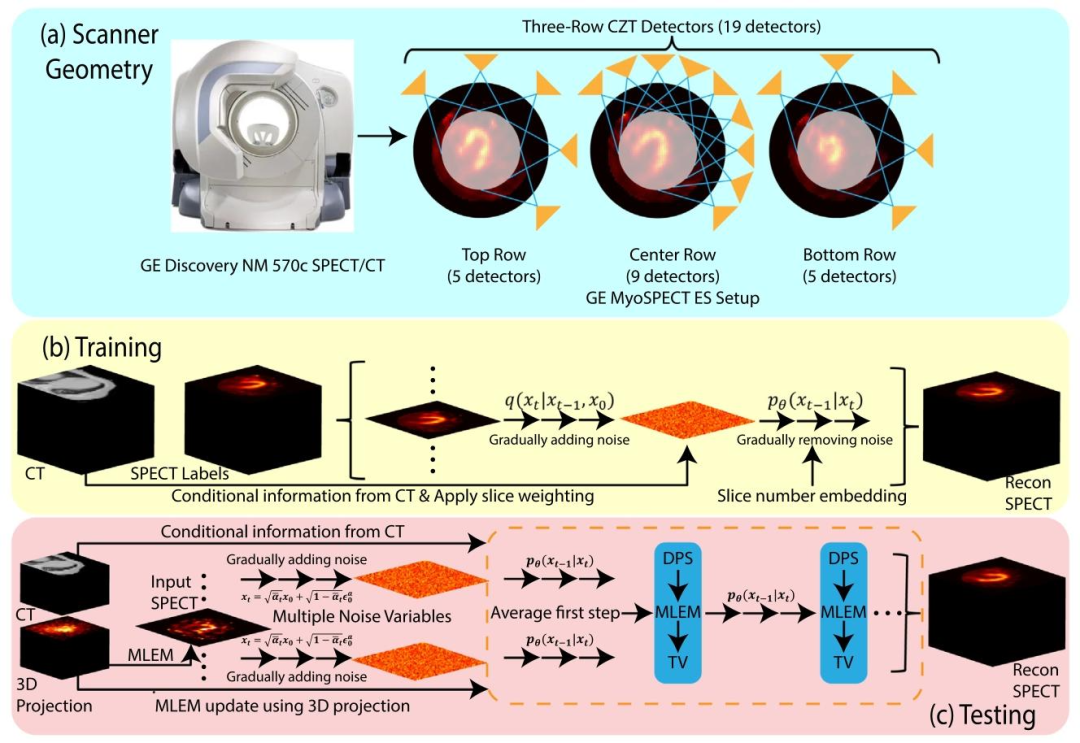
Fig. 1. (a) Overview of the scanner geometry used in this work. The scanner has a total of 19 CZT detectors arranged in 3 rows. By only including the center 9 detectors, wesimulated the geometry of the GE MyoSPECT ES system, a cost-effective version of the scanner. (b)–(c) Overview of the training and testing processes of the proposed DiffSPECT-3D,respectively. Training and testing procedures are detailed in Algorithms 1–2. In summary, we proposed several techniques to enforce consistency in both the image and projectiondomains, enabling DiffSPECT-3D to achieve improved reconstruction quality under various acquisition conditions. Anatomical information from CT scans is also incorporated inDiffSPECT-3D for better image quality
图1 (a)本研究中使用的扫描仪几何结构概述。该扫描仪共有19个CZT探测器,分3排排列。通过仅保留中间9个探测器,我们模拟了GE MyoSPECT ES系统的几何结构——这是该扫描仪的经济型版本。(b)-(c)分别为所提出的DiffSPECT-3D的训练和测试流程概述,训练和测试步骤详见算法1-2。总之,我们提出了多种技术以在图像域和投影域中增强一致性,使DiffSPECT-3D能够在不同采集条件下实现更高的重建质量。此外,DiffSPECT-3D还整合了CT扫描的解剖学信息,以进一步提升图像质量。
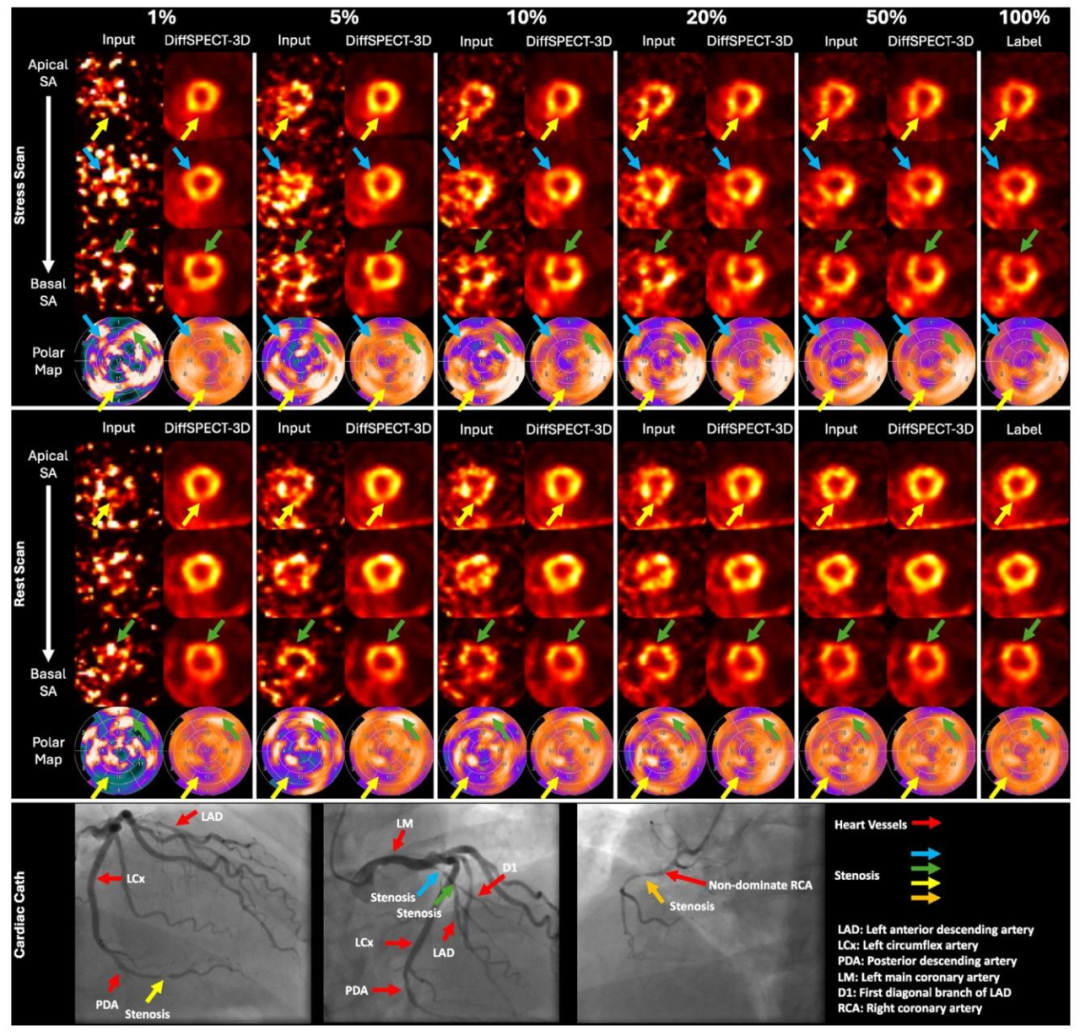
Fig. 2. A representative patient study reconstructed using the proposed DiffSPECT-3D with different low-count levels. Red arrows in the cardiac catheterization images point todifferent coronary vessels. Non-red arrows point to different perfusion defects in this patient. Arrows with the same color correspond to the same perfusion defect. This patienthas a large and critical stenosis in the proximal LAD (blue arrows), with an additional stenosis in the diagonal LAD (green arrows) and diffuse distal LAD disease. As pointed bythe yellow arrows, this patient also has a stenosis in the PDA of the dominant LCx. The stress and rest images show that the large anteroseptal defect (blue arrows) was reversiblewith some residual scar in the anterolateral wall within that defect (green arrows). Also, based on the stress and rest results, the mid-inferior wall defect is primarily fixed (yellowarrows). SA: short-axis.
图2 采用所提出的DiffSPECT-3D在不同低计数水平下重建的代表性患者研究案例。心脏导管检查图像中的红色箭头指向不同的冠状动脉血管,非红色箭头指向该患者的不同灌注缺损区域,相同颜色的箭头对应同一灌注缺损。该患者左前降支(LAD)近段存在严重狭窄(蓝色箭头),LAD对角支存在额外狭窄(绿色箭头),且LAD远端弥漫性病变。黄色箭头所示,该患者优势型左回旋支(LCx)的后降支(PDA)同样存在狭窄。负荷和静息图像显示,大范围前间隔缺损(蓝色箭头)具有可逆性,且该缺损区域内的前外侧壁存在部分残留瘢痕(绿色箭头)。此外,根据负荷和静息结果,中下段下壁缺损主要为固定性缺损(黄色箭头)。SA:短轴位。

Fig. 3. A representative patient study reconstructed using the proposed DiffSPECT-3D with different few-view settings. Red arrows in the cardiac catheterization images pointto different coronary vessels. Non-red arrows point to the perfusion defect in this patient. Arrows with the same color correspond to the same perfusion defect. The cardiaccatheterization image shows that this patient has a stenosis in the distal LAD (green arrows), leading to medium sized, mild to moderate intensity perfusion defects in the apex,apical inferior, apical anterior, and apical septal walls. Pink arrows point to few-view artifacts that were effectively suppressed by the proposed DiffSPECT-3D. The 9-view settingsimulates a GE MyoSPECT ES system. HLA: horizontal long-axis. VLA: vertical long-axis. Stress SPECT images are presented
图3 采用所提出的DiffSPECT-3D在不同少视角设置下重建的代表性患者研究案例。心脏导管检查图像中的红色箭头指向不同的冠状动脉血管,非红色箭头指向该患者的灌注缺损区域,相同颜色的箭头对应同一灌注缺损。心脏导管检查图像显示,该患者左前降支(LAD)远端存在狭窄(绿色箭头),导致心尖、心尖下壁、心尖前壁和心尖间隔壁出现中等大小、轻至中度的灌注缺损。粉色箭头指向少视角伪影,这些伪影已被所提出的DiffSPECT-3D有效抑制。9视角设置模拟了GE MyoSPECT ES系统的配置。HLA:水平长轴位;VLA:垂直长轴位。图中展示的是负荷SPECT图像。
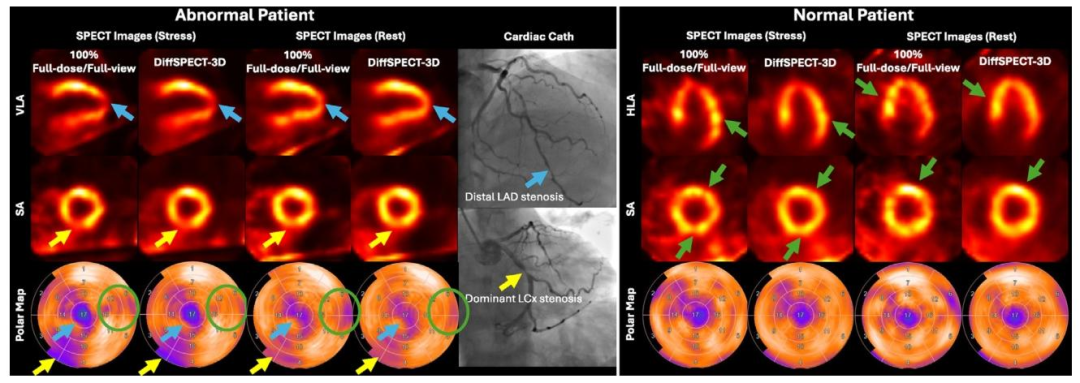
Fig. 4. One abnormal and one normal patient studies reconstructed using the proposed DiffSPECT-3D using full-dose/full-view images as input. The normal/abnormal status wasdetermined based on clinical diagnostic reports. Non-red arrows in the cardiac catheterization images point to the perfusion defect in the abnormal patient. Arrows with the samecolor correspond to the same perfusion defect. The cardiac catheterization image shows that the abnormal patient has a stenosis in the distal LAD (blue arrows), and anotherstenosis in the dominant LCX (yellow arrows). For the normal patient, the lower uptake apical wall may be attributed to apical thinning, as noted in the diagnostic report.Catheterization was not performed for the normal patient. Green arrows/circles indicate different noisy artifacts that were effectively suppressed by the proposed DiffSPECT-3D.HLA: horizontal long-axis. VLA: vertical long-axis. SA: short-axis. LAD: left anterior descending artery. LCx: left circumflex artery
图4 采用所提出的DiffSPECT-3D以全剂量/全视角图像为输入重建的1例异常患者和1例正常患者研究案例。患者的正常/异常状态根据临床诊断报告确定。心脏导管检查图像中的非红色箭头指向异常患者的灌注缺损区域,相同颜色的箭头对应同一灌注缺损。心脏导管检查图像显示,该异常患者左前降支(LAD)远端存在狭窄(蓝色箭头),优势型左回旋支(LCx)存在另一处狭窄(黄色箭头)。对于正常患者,诊断报告指出心尖壁摄取降低可能归因于心尖变薄,该患者未进行导管检查。绿色箭头/圆圈标记的不同噪声伪影已被所提出的DiffSPECT-3D有效抑制。HLA:水平长轴位;VLA:垂直长轴位;SA:短轴位;LAD:左前降支;LCx:左回旋支。
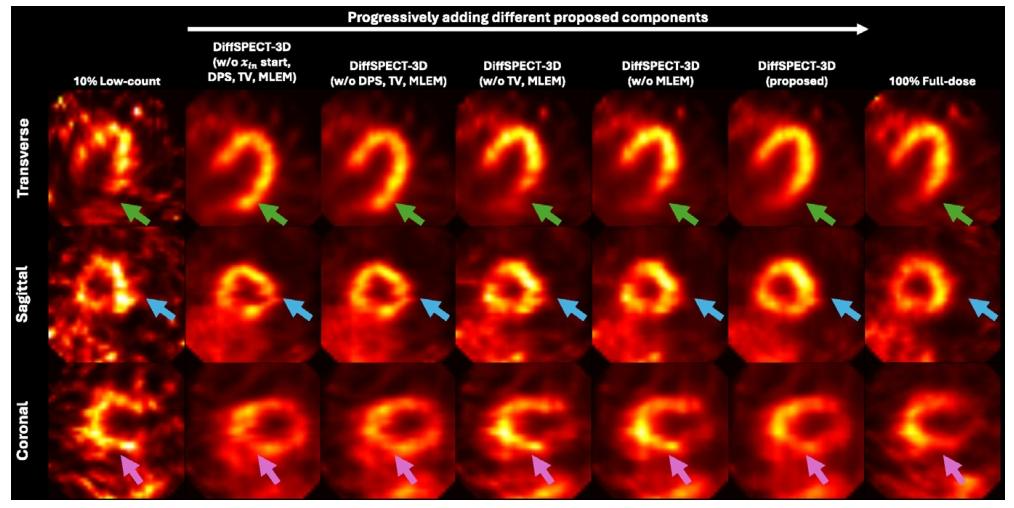
Fig. 5. Results from a testing case to demonstrate the effectiveness of different proposed components in DiffSPECT-3D. Arrows point to regions that were effectively recoveredusing the proposed components.
图5 测试案例结果,用于验证DiffSPECT-3D中所提出的不同组件的有效性。箭头指向通过所提组件得到有效恢复的区域。
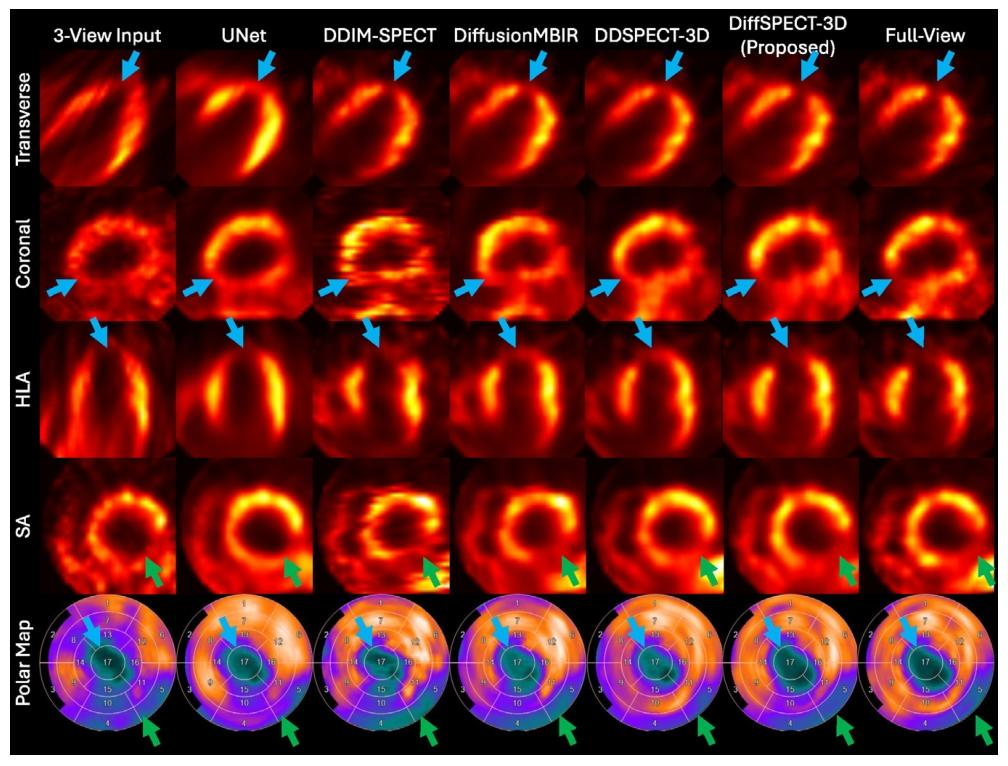
Fig. 6. Results from a testing case reconstructed using different methods. Arrows with the same color correspond to the same perfusion defect. The perfusion imaging of thispatient shows a medium-sized, severe-intensity fixed perfusion defect in the entire apical walls (blue arrows), and a small to medium-sized, severe-intensity fixed perfusion defectin the basal to mid-inferolateral wall consistent with scar (green arrows). HLA: horizontal long-axis; SA: short-axis
图6 采用不同方法重建的测试案例结果。相同颜色的箭头对应同一灌注缺损。该患者的灌注显像显示,整个心尖壁存在中等大小、重度的固定性灌注缺损(蓝色箭头),基底至中段前外侧壁存在小至中等大小、重度的固定性灌注缺损,符合瘢痕表现(绿色箭头)。HLA:水平长轴位;SA:短轴位。
Table
表

Table 1Quantitative assessment for ablated methods. The measurements were obtained by averaging the values on the testing human studies. The proposed method consistently producedpromising reconstruction results regardless of input count levels and few-view settings. ↑ and ↓ indicate that higher and lower values are better, respectively, for each metric
表1 消融方法的定量评估结果。测量值为测试集人体研究案例的平均值。无论输入计数水平和少视角设置如何,所提出的方法均能稳定生成理想的重建结果。↑和↓分别表示各指标中数值越高越好和越低越好。
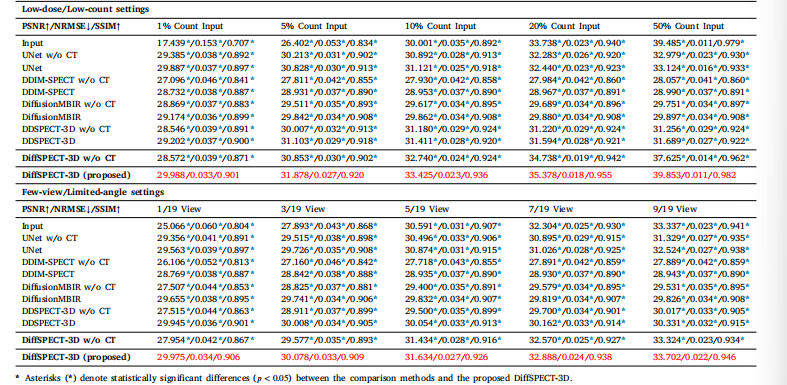
Table 2Comparison between different deep learning methods. The measurements were obtained by averaging the values on the testing human studies. The proposed method consistentlyproduced promising reconstruction results regardless of input count levels and few-view settings. ↑ and ↓ indicate that higher and lower values are better, respectively, for eachmetric
表2 不同深度学习方法的对比结果。测量值为测试集人体研究案例的平均值。无论输入计数水平和少视角设置如何,所提出的方法均能稳定生成理想的重建结果。↑和↓分别表示各指标中数值越高越好和越低越好。